May 22. We are rise early this morning for a private bird watching excursion on a 64-acre site of coastal vegetation, which is habitat for over 60 species of birds, some which are are only native to Borneo.
As our days in Borneo will largely be spent viewing birds and other flora and fauna, they may seem repetitive, or even boring. Those who have been on safari or birding and wildlife trips will appreciate that this is not the case. Setting out each day, one cannot predict what you’ll see and the adventure and fun is in the hunt as much as in the finding. Changing environments and weather, and the sheer difference from our lives back home all serve to enhance the adventure.
Our guide this morning, Andrew, was one of the people who picked us up at the airport when we arrived the other night. He is an expert birder adept at pointing out different species. Happily, this morning we were on flat terrain and along a golf course, as opposed to yesterday in the forest. The open areas made it possible to see birds.
For those of you not familiar with birds/birdwatching, here are a few points to keep in mind. Birds are very small. Birds move very fast. Birds are hard to find in your binoculars or camera lens. So birdwatching and bird photography can be very frustrating, especially when it’s hot as hell and you’ve forgotten to take water with. That said, here are a few unsatisfactory photos from this morning. 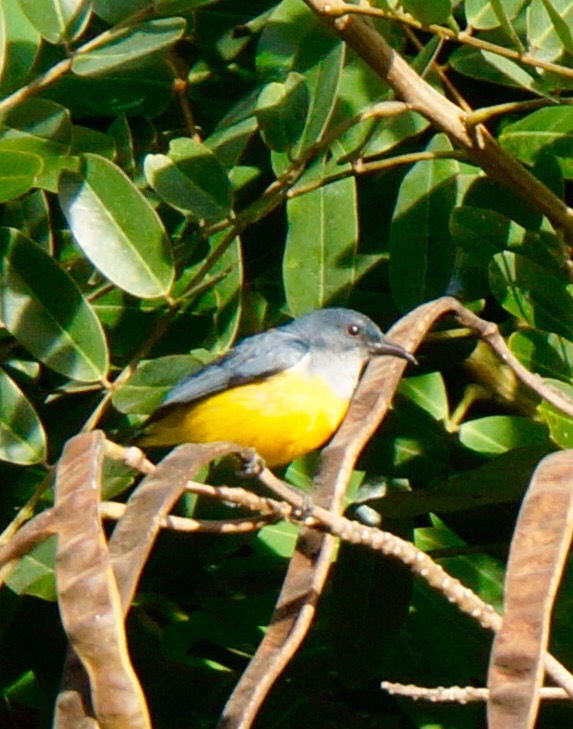 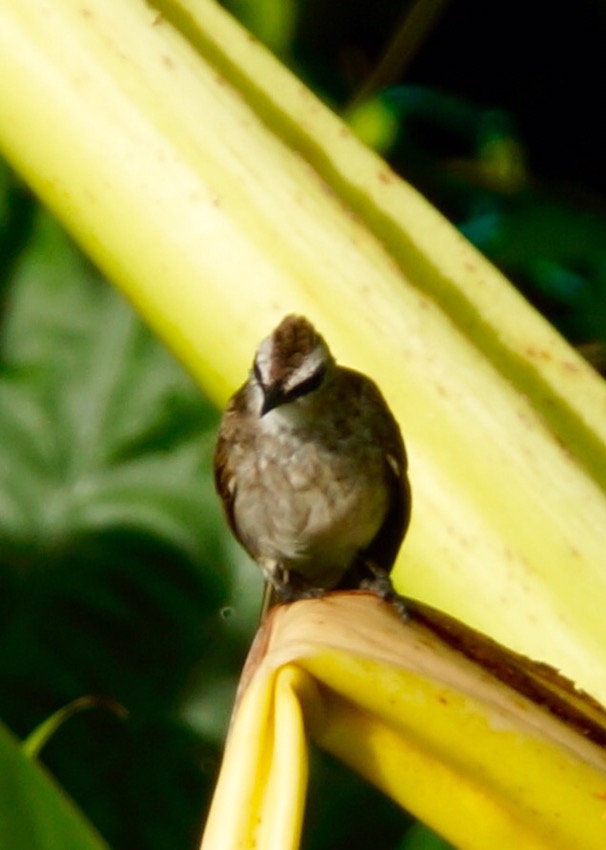  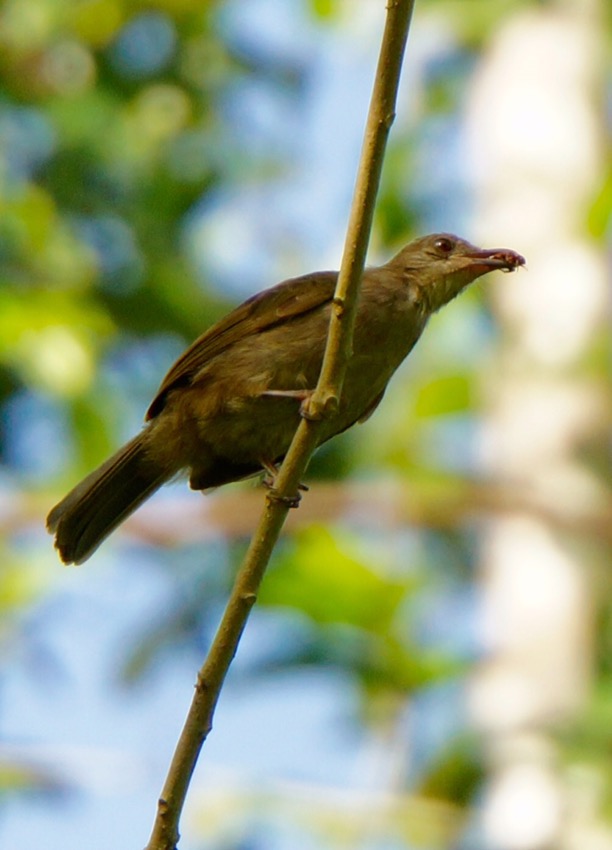
Michael, laden with equipment, and a distant golf cart make easier targets.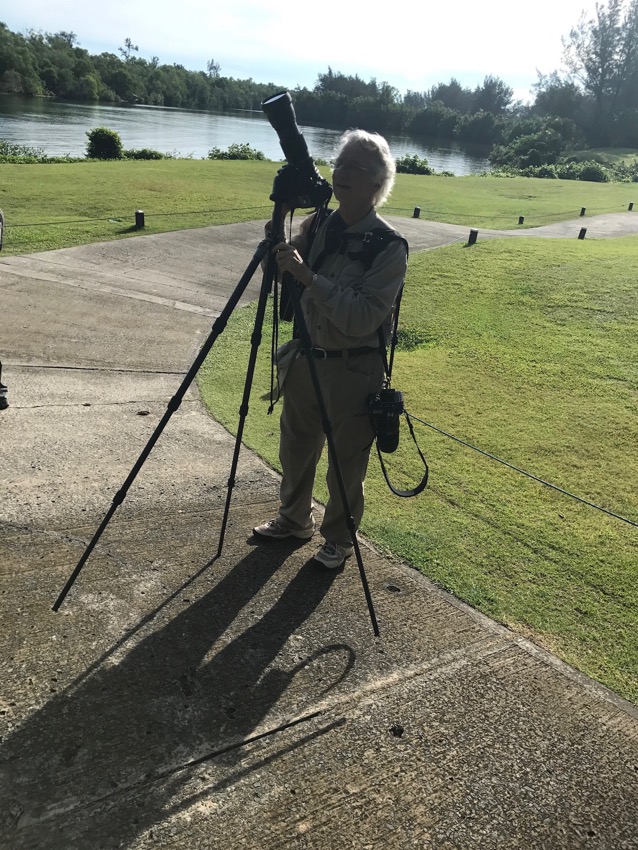  
We return to the resort for a fine buffet breakfast, then rest up before this afternoon’s walk with Andrew. During our rest-up period, a high point of the trip (so far) occurs–the laundry I sent out this morning is returned, clean, pressed and folded. I am so excited, and it was a bargain, fifteen bucks for the whole lot! It’s things like this that make life worth living. Witnessing my joy, Carol says that she’s going to start charging me for doing the laundry, and I tell her that I’ll happily pay.
Relatively light lunch in the hotel. Musicians in lobby were singing goodbye to guests who were leaving.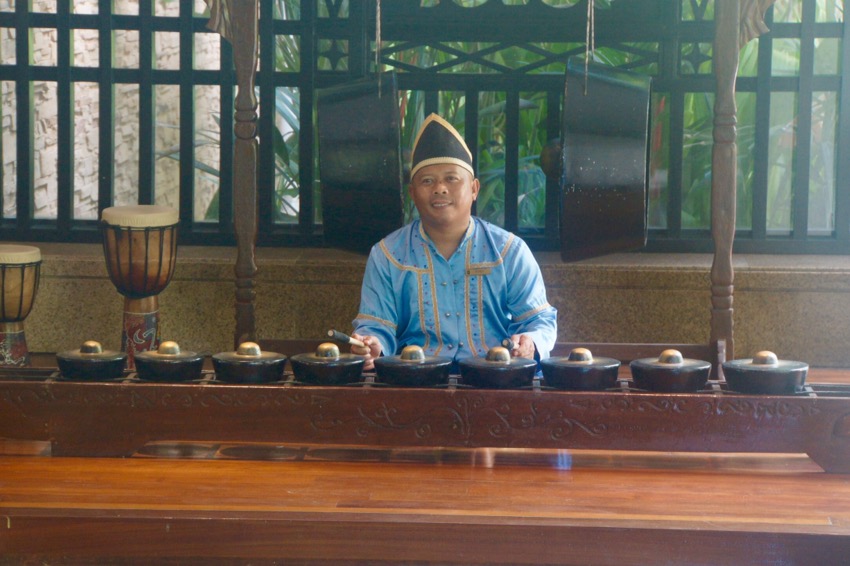 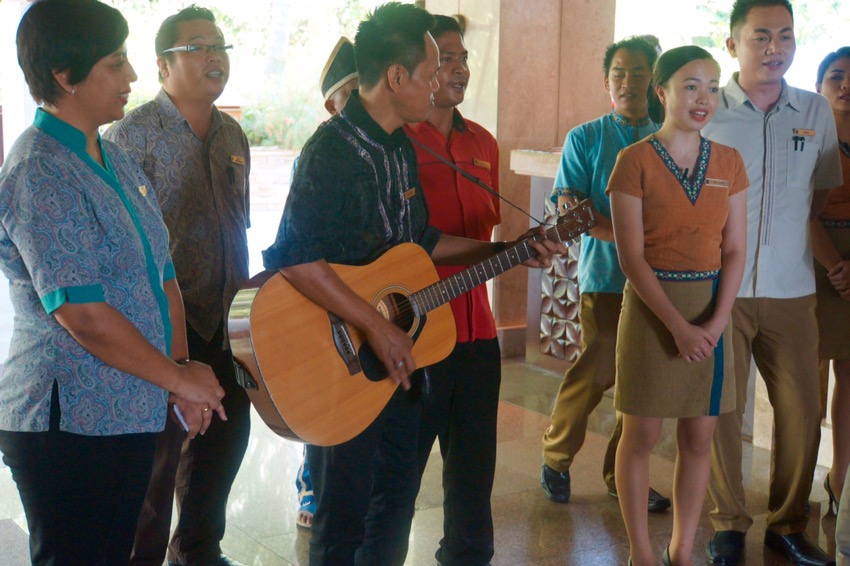
Our guide, Andrew
led us on a walk right near the hotel for only about an hour, which was long enough, given the heat. Here are some of our sightings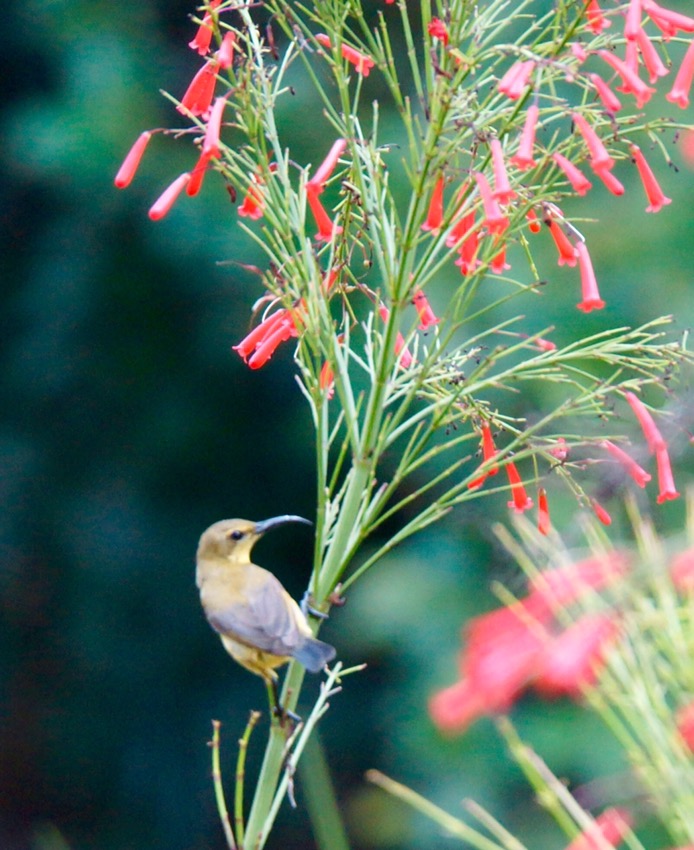  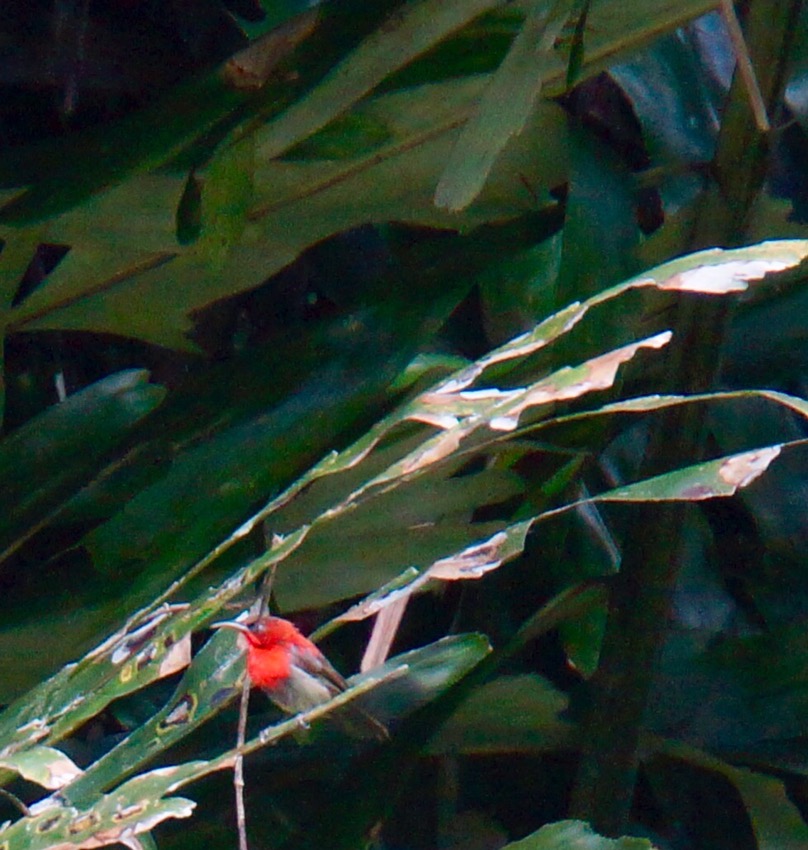  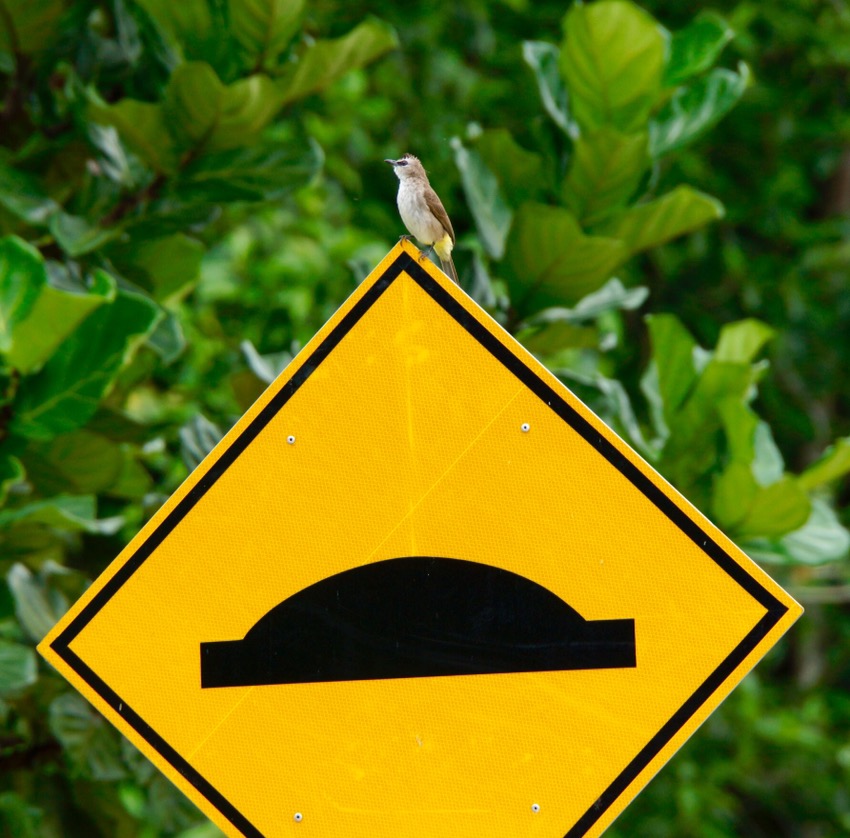 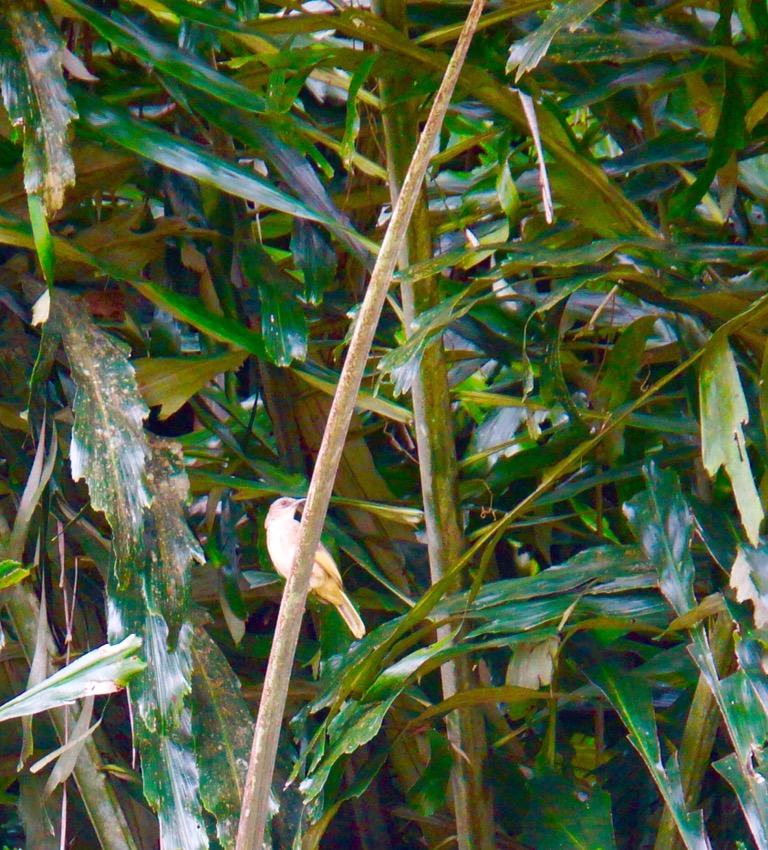 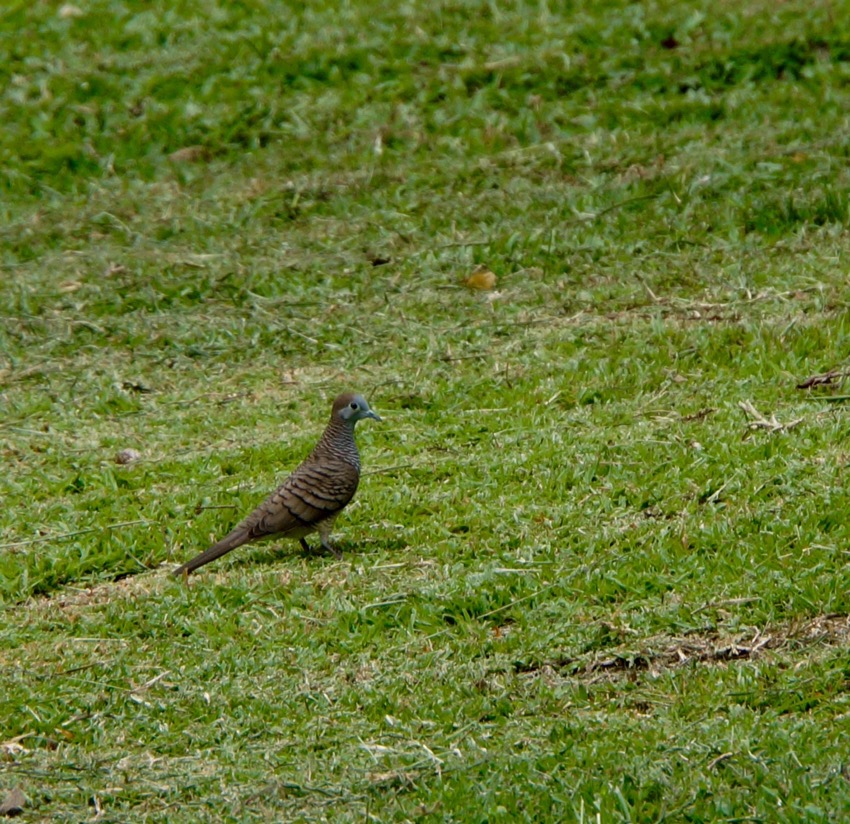  
Cleaned up our sweaty selves in time for cocktails and dinner at the Indian restaurant in our resort, called Naan. Excellent dinner, then up to the room to pack and retire by 9PM, for tomorrow’s very early start
May 21. To close the book on yesterday, it was indeed a long day, about twenty-seven hours from the time we left our hotel in San Francisco until the time we arrived at our hotel in Borneo. Though we encountered delays and curves in navigating our way through the Seoul airport and onto our flight to Kota Kinabalu, our long layover meant that we felt no anxiety about missing connections. The Seoul airport is large and modern, with evidence of Western influence everywhere, from Starbucks to Burger King to Jamba Juice. Here’s a photo of constantly changing images in a glass panel suspended from the ceiling inside the airport.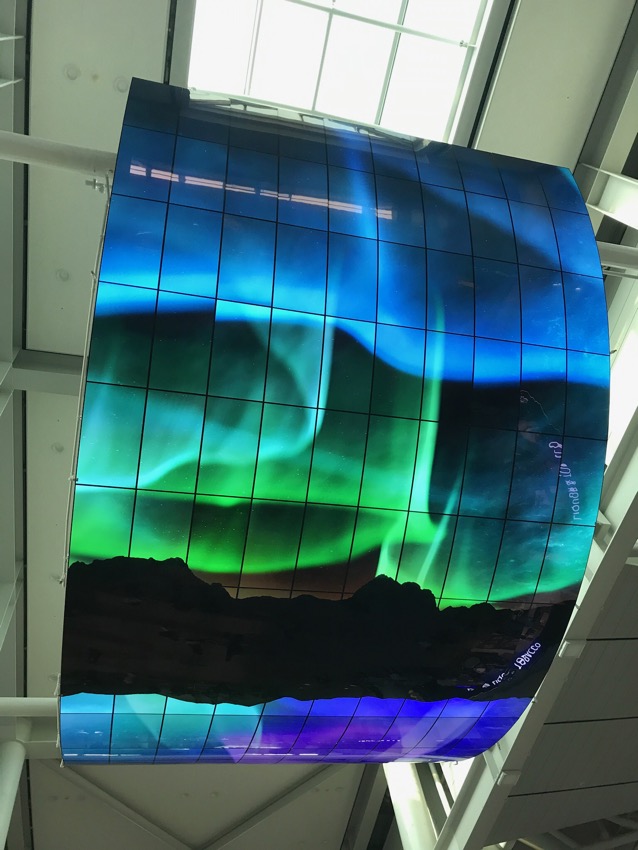
Our 5-hour flight to Kota Kinabalu, which we could track here in English and Korean  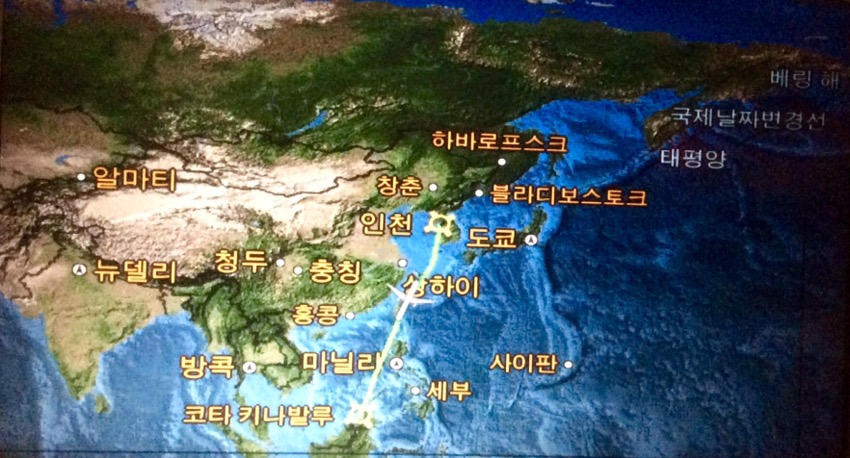
was uneventful, and I read some, and tried to rest. The greeting at the airport and 45-minute transfer to our hotel went as planned. Arriving at the hotel at 1AM, we were shown around, showered and crashed.
Before I left on the trip, I had looked into the possibility of scuba diving today, but the logistics were sufficiently complicated to discourage me from signing up. This, I think, is a good thing.
So, instead of diving, today we relax around the resort to recover from the long trip over. The hotel, the Rasa Ria Resort & Spa, and our spacious room are both quite beautiful, far more upscale than I’d expected.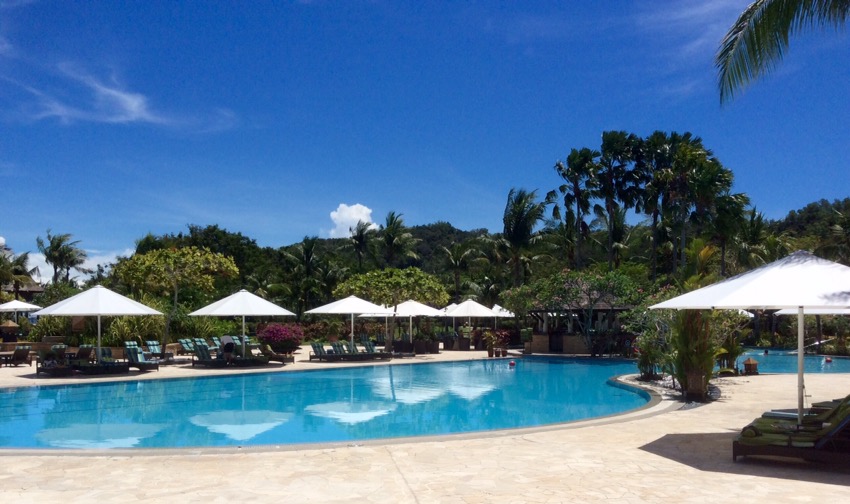
Excellent buffet breakfast with the Lewises.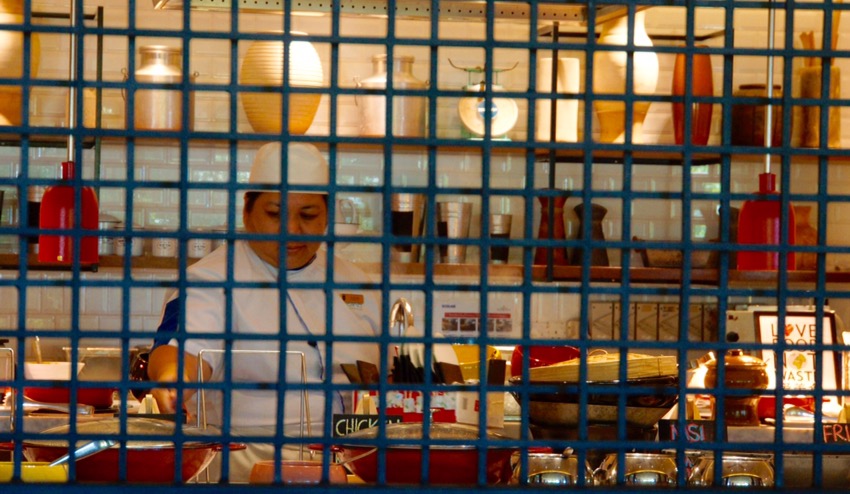
And a couple bird photos around the hotel (of a chestnut Munia and an Asian glossy starling), confirmed that the lens I have is not really long enough (but I’ll have to make do).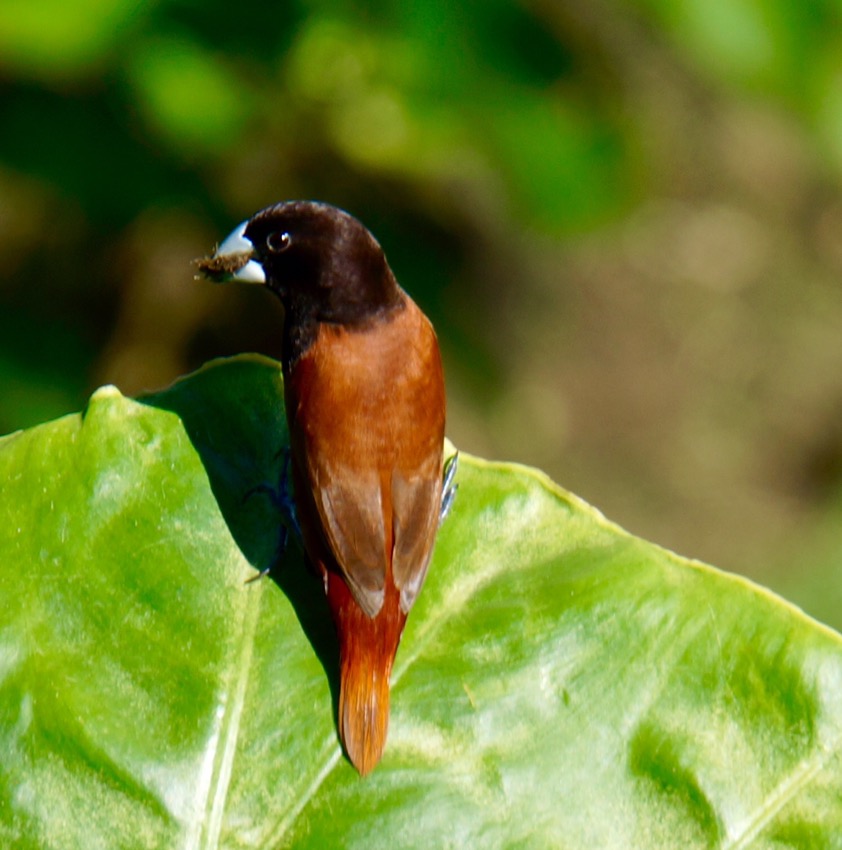 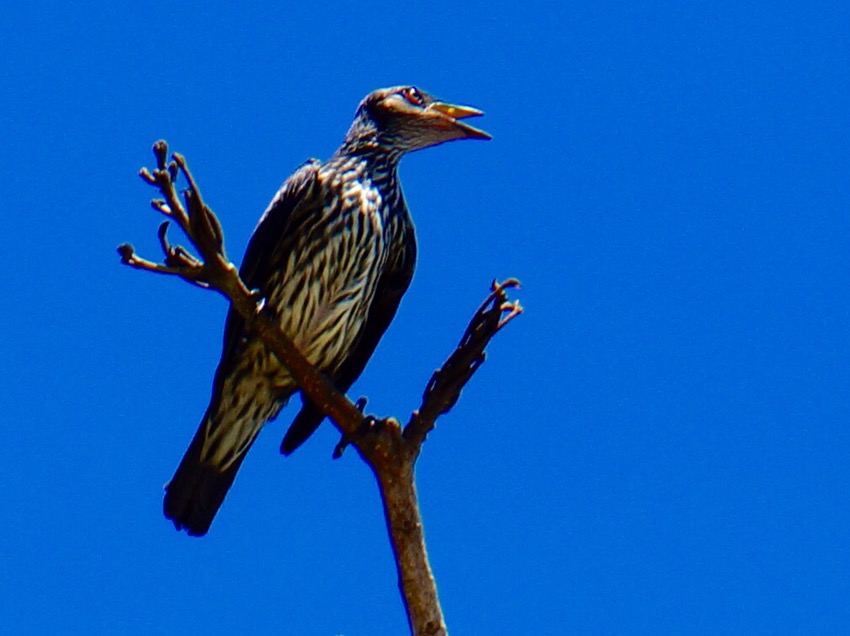
After lunch, we go on our first nature walk, two hours on the resort grounds, a quite strenuous uphill and downhill trek in considerable heat. Here are shots of Mike, with gear, our ranger/guide, LeRoy, and a stunning flower.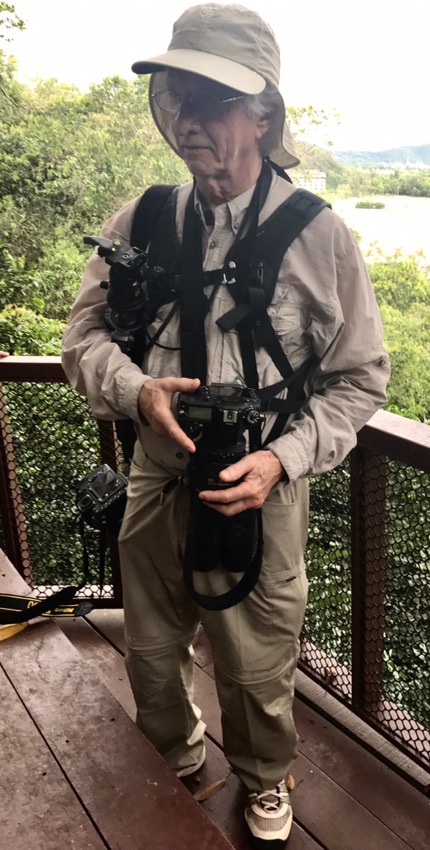 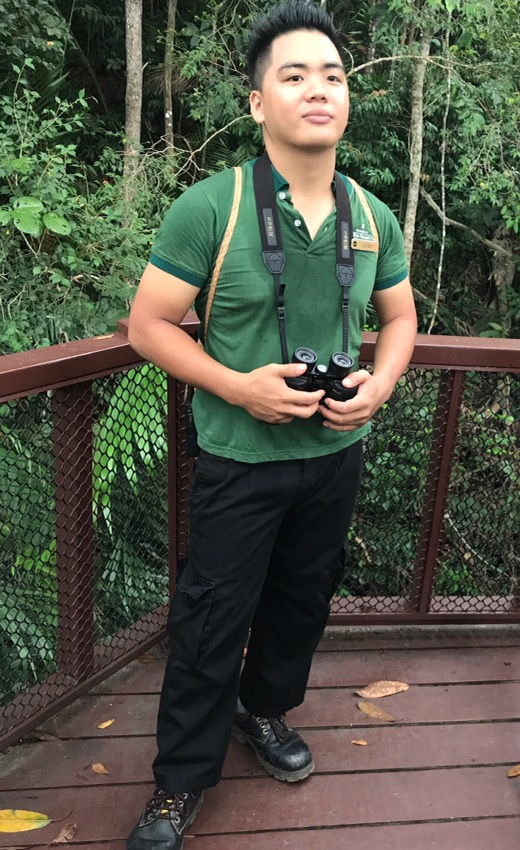 
After the hike, we watch a nature film regarding the rehabilitation of an orangutan, then go for cocktails and canapés, before having a delicious dinner at the Italian restaurant in the resort. We narrowly miss a torrential, tropical downpour. After dinner, tired from the hike and aware of an early start time tomorrow, we shower and retire early.
In closing for the day, I’ll quote from our materials from the travel company, which caution us to adhere to the social proprieties of the area:
It is of great importance to give and receive things, particularly food, with your right hand. Never use your left hand to dip into a common food dish. The left hand is reserved for unclean tasks and is considered filthy.
Keep a pleasant attitude. Never display anger. Criticism of others is in very bad taste. If you have a complaint, be extra calm and polite while stating your problem. To show anger or raise your voice will only ensure that your request will either not be granted or will be greatly delayed.
Please remember that although you may see less considerate visitors doing it, nude or topless sunbathing and skimpy bikini swimwear are offensive to Malaysian eyes. Away from the cities, many people bathe au naturel in the streams and rivers of their island. Please respect their privacy and do not stare at nor photograph them.
As a predominantly Muslim country, dressing modestly and appropriately is very important. While on the beach or trekking through the jungle, shorts and tank tops are acceptable. However, while in the cities, arms and legs should be adequately covered. This is particularly true on the east coast of the peninsula.
Public displays of affection between members of the opposite sex are considered very poor manners; thus, men and women, even if married, should avoid such behavior, even to the extent of avoiding holding hands.
Most of these guidelines seem pretty easy to follow, especially once I got Carol to tie my left hand behind my back. This precaution also has the benefit of reducing by half the risk of offending locals by holding hands with Carol.
May 20. Today is the long haul from San Francisco to Borneo, with a stop in Seoul, South Korea. The Seoul leg is about 12 1/2 hours and we’re traveling business class, using miles. These long air trips are a price one pays for getting to the remote places we choose to visit. They’re well worth it and, to the extent it’s possible, we’re used to them.
What does one do for12 1/2 hours, other than eat and drink? Read a thought-provoking book called FALLING UPWARD, by a Franciscan minister named Richard Rohr, about the tasks of the two halves of our lives. At almost 75, thinking about a “second half” seems a bit optimistic, but there are certainly thoughts to be taken away. Also watched a movie called Billy Lynn’s Long Halftime Walk, based on a terrific novel with the same title. Movie did a good, faithful job with the book. Saw a piece on the art of comedy, which went on a bit long, but was interesting enough. And, of course, some blogging.
As we have a 5- hour layover in Seoul, we looked into taking a short tour from the airport, but concluded that that would not work. We were unable to check bags through from San Francisco to Borneo, so we have to go through customs, fill out forms, search for Air Seoul, our next airline. Fortunately we have lots of time.
This may be an appropriate place to tell you something about our travel companions and good friends, Michael and Valerie Lewis, shown here at the San Francisco airport.
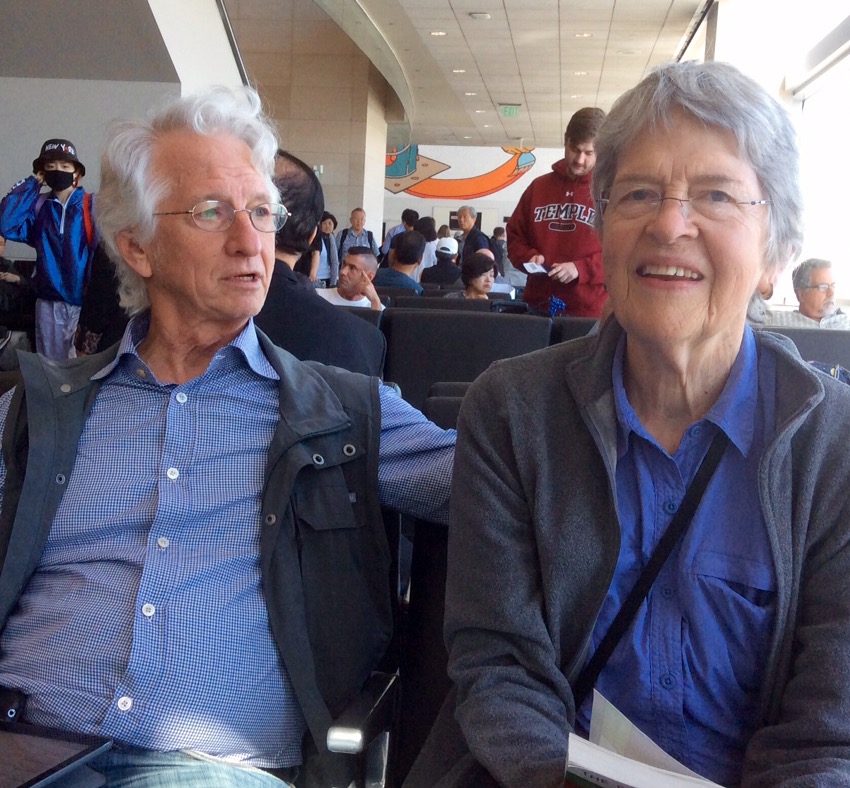 Michael is a Brandeis classmate of ours, an orthopedic surgeon and an accomplished photographer and tennis player. He is able to work the fact that he was orthopedist for the Chicago Bulls during the Michael Jordan era seamlessly into any conversation, as in, “Oh, it looks a bit cloudy out. That reminds me of the time when it was a bit cloudy when I was the doctor for the Bulls, when Michael Jordan was playing.” Michael is a Brandeis classmate of ours, an orthopedic surgeon and an accomplished photographer and tennis player. He is able to work the fact that he was orthopedist for the Chicago Bulls during the Michael Jordan era seamlessly into any conversation, as in, “Oh, it looks a bit cloudy out. That reminds me of the time when it was a bit cloudy when I was the doctor for the Bulls, when Michael Jordan was playing.”
Michael has been very helpful to me in my development as a photographer, and saved Carol and me countless hours in guiding us through the steps of producing our two books of photography and poetry, based on his experience in producing a beautiful book of his own photography. He’s been off of photography for many years, but purchased roughly $300,000 of new equipment (weighing approximately as much as an adult orangutan) in preparation for this trip. This blog will not feature Michael’s photographs (I’m nothing if not competitive).
Michael is best known for his mother, Beadie, a totally remarkable lady whose 100th birthday Carol and I were privileged to celebrate earlier this year in a Houston.
Valerie requires little space to describe, as she’s just fabulous in every way. A Brit, who traveled the world solo as a young woman, she is an accomplished birder, among many, many other accomplishments. Her most remarkable achievement is having put up with Michael for some 42 years of marriage.
We have been close friends of the Lewises since approximately the time we learned to talk. We traveled with them to Alaska and later went dogsledding with them in Wyoming some 20 or so years ago and now feel that we’ve recovered from those experiences sufficiently to give it another go. We’ll see.
The second leg of our long plane trip will be a short five hours. We will land in Kota Kinabalu, the capital city of the state of Sabah with a population of 400,000. This city has a beautiful setting right on the South China Sea with the backdrop of Mt. Kinabalu, which at 13,455 feet, is the highest peak in SE Asia. As it was completely bombed during World War II, it is a very new city. Kota Kinabula provides easy access to the nature sites to which we will be traveling.
If all goes well, we’ll be met at the airport, and driven north about 45 minutes to our resort on Pantai Dalit Beach, the Shangri-La Rasa Ria, set amidst a nature reserve, surrounded by 400 acres of tropical forest. And then, we hope to settle into our rooms for a well deserved night’s rest.
I’m posting this now, because I have wifi in the Seoul airport. Not sure what we’ll find wifi-wise in Borneo, so if there are some gaps, that will be the reason.
May 19. Okay, so here is the post in which I tell you more about where we’re going than you can possibly want to know, derived from sources from which I steal the information. Don’t feel badly if you don’t retain much of this. I won’t, either.
I’m publishing this from San Francisco, where we arrived yesterday evening and stayed at an airport La Quinta Hotel in order to break up (a tiny bit) today’s long flight to Borneo. I’ll write more aloft and hope to be able to post when we arrive.
Malaysia is divided almost equally between the narrow strip of land known as Peninsular Malaysia and the northern half of Borneo Island. The two sections are separated by over 300 miles of the South China Sea. Despite this separation, the two areas are geographically and ecologically similar, and in fact, were connected during the ice age by the rainforest covered land bridge of Sundaland. Both sides have areas of dense jungle, high mountains, and long winding rivers. Coastal Malaysia is typified by white sand beaches, amazing coral reefs and coconut groves. One of Southeast Asia’s highest peaks, Mt. Kinabalu towers 13,454 feet above Sabah’s lush forests. The Rejang River and the Kinabatangan flow for over 350 miles through Borneo.
.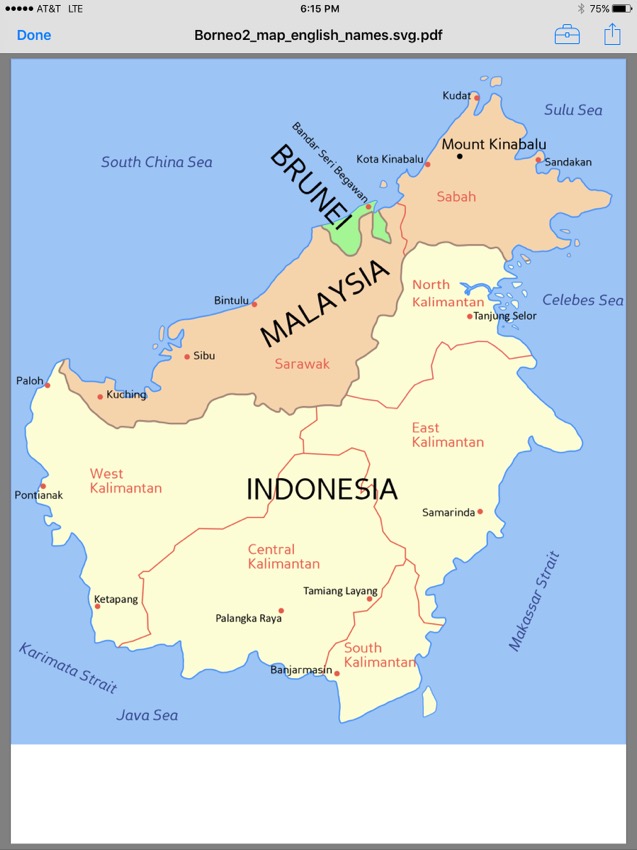 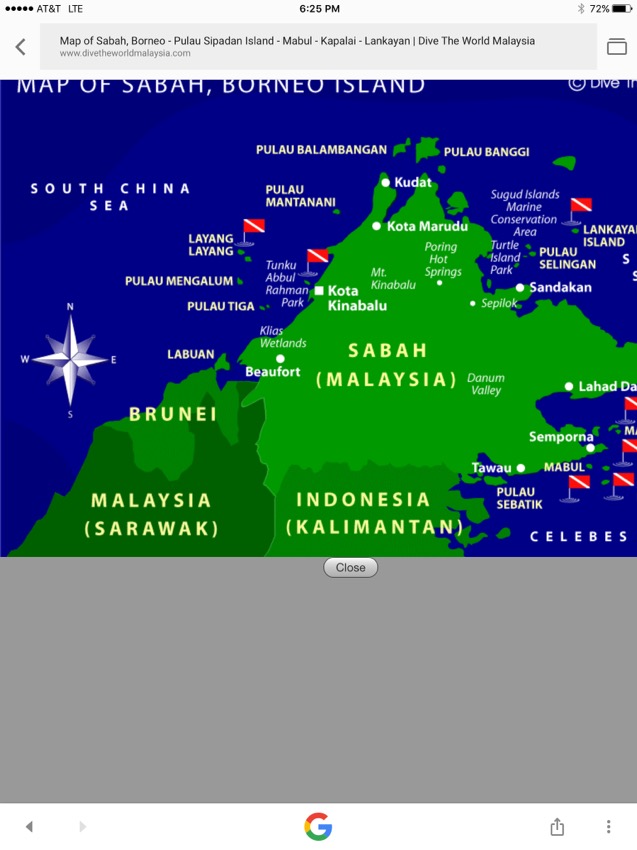 Approximately seventy percent of Malaysia is covered with rainforest; it is no wonder that both Peninsular Malaysia and Malaysian Borneo have impressive national parks. The oldest and largest on the peninsula is Taman Negara, which covers over 2,500 square miles. Gunung Tahan, the tallest peak in peninsular Malaysia is 7,173 feet high and within the parks boundaries. Sabah and Sarawak’s national parks are more numerous, but smaller in size. The largest being the 2460 square mile park around Mt. Kinabalu. Gunung Mulu, in Sarawak, contains approximately 1500 different species of flowering plants as well as the 30 mile long cave system. Approximately seventy percent of Malaysia is covered with rainforest; it is no wonder that both Peninsular Malaysia and Malaysian Borneo have impressive national parks. The oldest and largest on the peninsula is Taman Negara, which covers over 2,500 square miles. Gunung Tahan, the tallest peak in peninsular Malaysia is 7,173 feet high and within the parks boundaries. Sabah and Sarawak’s national parks are more numerous, but smaller in size. The largest being the 2460 square mile park around Mt. Kinabalu. Gunung Mulu, in Sarawak, contains approximately 1500 different species of flowering plants as well as the 30 mile long cave system.
Some of the more interesting fauna of Malaysia are the extraordinarily rare Sumatran rhinoceros, the clouded leopard, Malaysian tiger and herds of wild Asian elephants. Unfortunately, we are unlikely to see these animals on our trip, but we should (read: damn well better) see the mighty orangutans of Borneo. We may also encounter the proboscis monkey, several types of macaques, civet cats, tapirs, pangolin (scaly anteater) or the gaur, a member of the wild ox family that can weigh up to 3000 pounds.
Malaysia’s most famous flower is also the world’s largest, the rafflesia. This strange carnivorous flower lives underground until it blooms, can grow up to a meter wide and smells of rotting flesh (a trick for catching flies). Over 14,500 other species of flowering plants inhabit Malaysia, many of which are flowering trees and shrubs. From the rare stare fungus and thysmia to a proliferation of pitcher plants, orchids and ginger flowers we are certain to see colorful and wonderful flora while in Malaysia.
History
The native inhabitants of Malaysia, called the orang asli made their homes in the mountainous jungles of the interior peninsula starting some 10,000 years ago. These people were eventually absorbed into the culture of the sea-faring Malays who landed on Malaysia’s coasts after long journeys from islands near the Philippines. The Malays weren’t the only people interested in the peninsula though. Due to its prime location on the shipping routes, the Indians also set up settlements with the Malays, which soon became thriving and splendid kingdoms. The great Hindu kingdoms’ seat of power finally came to rest in Malacca.
The great Malay kingdom did not reach its zenith of power until the court’s conversion to Islam. By the 15th century, the Islamic kingdom of Egypt controlled the spice trade to Europe and allowed only Muslims to ship the goods. The newly converted Malay kingdom of Malacca was incorporated into this trading group and soon grew fabulously wealthy.
This greatness came to a halt, though, when the Portuguese took Malacca after a month long siege in 1511. Despite their efforts, the Portuguese were unable to take over Malacca’s role in the lucrative spice trade. Rather than deal with the heathen westerners, the wealthy Muslim traders took their business to Islamic Sumatra. The Portuguese held onto the city for over one hundred years, until the Dutch took over in a violent battle. However, the Dutch continued the isolationist policies of their predecessors and Malacca continued to decline. By this time, most of Peninsular Malaysia was controlled by several Sultanates, who battled the encroaching Thai to the north as well as the Dutch.
The British became interested in the area at the end of the 18th century, establishing the port of Penang in 1786 and Singapore in 1818 and it was not long before they controlled everything in between the two, including Malacca. The British soon realized that Malaysia had rich stores of tin and that the Brazilian rubber plant was well suited for the environment. British Malaysia soon became the world’s largest supplier of both. The British had also, by this time, taken control of most of what is today Malaysian Borneo through the British North Borneo Company.
The period of British prosperity in Malaysia ended abruptly with the Japanese invasion of 1941. The swift defeat of the British by the Japanese destroyed the idea of British infallibility in the Malaysian mind. When the British returned in 1945, they found a population that was no longer willing to be second class citizens in their own country. The Malays and Chinese organized themselves into separate organizations pushing for independence and reforms. In Malaysia’s first national election in 1955, an alliance of the two main groups won a large majority. In 1957, the British relinquished sovereignty over Malaysia and Independence was granted.
The Federation of Malaysia was formed in 1961 and originally included the Malaysian Peninsula, Sabah, Sarawak, Brunei and Singapore. However, Singapore and Brunei declined to be in the Federation as they were reluctant to share their wealth with the poorer states. Despite some initial racial tension, regional conflict and economic rebuilding, Malaysia has become a leader in the Southeast Asian political and economic community.
People
Malaysia is one of Southeast Asia’s most ethnically diverse countries. Malay, Chinese, Indians, Europeans and many different groups of indigenous peoples coexist under a single “Malaysian” identity. The majority of the people are of Malay descent. The Malays control most aspect of the government and are predominantly Muslim. Bahasa Malaysia is the primary language of the Malay, but English is also used, particularly when dealing with the other ethnic groups. Until recently, the majority of Malay people lived in the countryside, however, continued government efforts to involve them in the economy has spurred a migration of the Malays from the country to the city.
The Chinese comprise about 35 percent of Malaysia’s population. Most arrived in Malaysia during the 19th and 20th centuries from the southern provinces of China, though there are groups of Chinese (the Babas, or Peranakans) that can trace their ancestry in Malaysia to the 15th century. Similar to other Southeast Asian countries, the Chinese control much of the Malaysian economy.
Indians make up about 10 percent of Malaysia’s population. Brought from India by the British to provide plantation labor, the Indians are still one of Malaysia’s most disadvantaged ethnic groups.
The indigenous groups of Malaysia range from the remaining orang asli of Peninsular Malaysia to the Dayaks of Borneo. There are hundreds of different tribes throughout the country, with many unique traditions and cultures. Many of the Dayak tribes in Borneo still live in the traditional longhouses and retain much of their culture and traditions. However, most Dayak tribes have been influenced by modern culture, so it’s not unusual to see a satellite dish poking up from one end of a longhouse.
Religion
The religions of Malaysia are as varied as its people. Though Islam is the national religion and is followed by most of the Malay population, Malaysia’s constitution guarantees freedom of religion. Most Chinese follow a mixture of Taoism, Confucianism, and Buddhism and most Indians are Hindus, Muslims, or Sikhs. It is common to have mosques, Buddhist temples, and Hindu shrines within blocks of one another in any Malaysian town. In Malaysian Borneo, most of the indigenous tribes still follow animistic traditions, but Christian missionaries have had their influence, and the number of Dayak Christians has grown considerably.
Okay, enough already, right? Relax. There will be no quiz. And future posts will be a whole lot less dense.
And, finally, here are our dinner companions in San Francisco last nigh–Matt Oshinsky, the son of our close Brandeis classmate, Len Oshinsky, and Matt’s two terrific sons, Ryan and Caleb. Arranged this dinner from the airport in Chicago. An unexpected treat.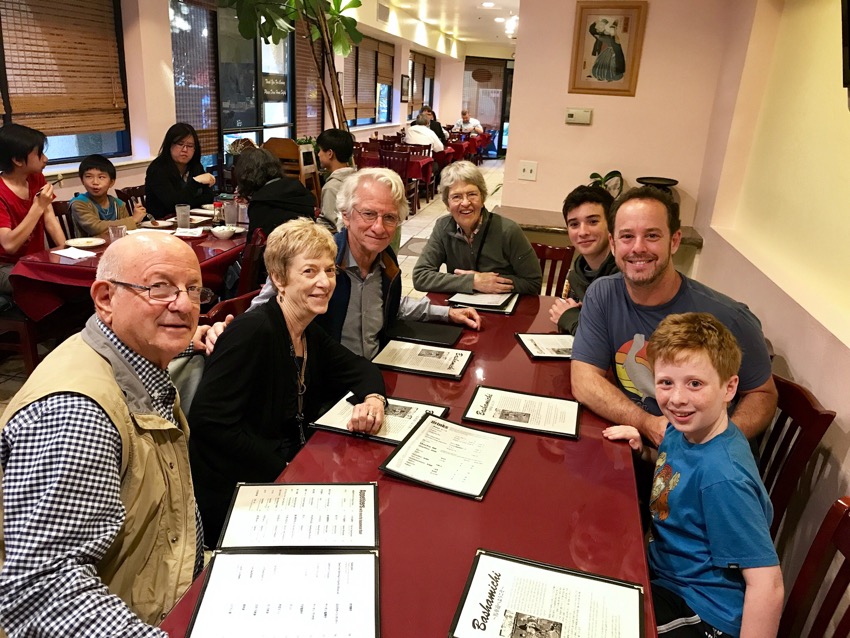
May 18. We set off on our next adventure tomorrow. Borneo is our primary destination. Friends have asked where Borneo is, and why Borneo. As to the first, I’m relying rather heavily on the pilot. But I know at least that, like many places to which we travel, it’s really far.
Borneo is someplace between Malaysia and Indonesia. Actually, Borneo is part of both of those countries, as well as containing a small country called Brunei that is part of the island called Borneo. We are going to the Malaysian part of Borneo. (I won’t confuse you now by explaining why we are ending our trip on the non-Bornean part of Indonesia.). I’ll include another map or two in my next post.
As to why Borneo, that stems from Carol and I having met a couple, Lluis (not a typo) and Silvia (also not a typo) Sanz, when we were birding in Ecuador a couple years ago. (Unfortunately, I don’t have a photo of them, but, from my blog, I know that we met them on June 21, 2015.) They were from Spain and he was a very serious birder who did illustrations of birds for books and led birding trips through his small travel company. Silvia, a physician, was also an enthusiastic birder. Because Lluis raved about Borneo, Carol and I became interested in going there and, in fact, exchanged a couple emails with Lluis exploring the possibility of going there with him. Ultimately, though, we decided to engage a large, US-based company to help us plan the trip. Because of our impending trip, I got in touch with Lluis via email a week ago, and he responded within a day, giving us some helpful hints for Borneo and saying that he’d be following my blog. And, at my request, he just sent these photos of him and Silvia. 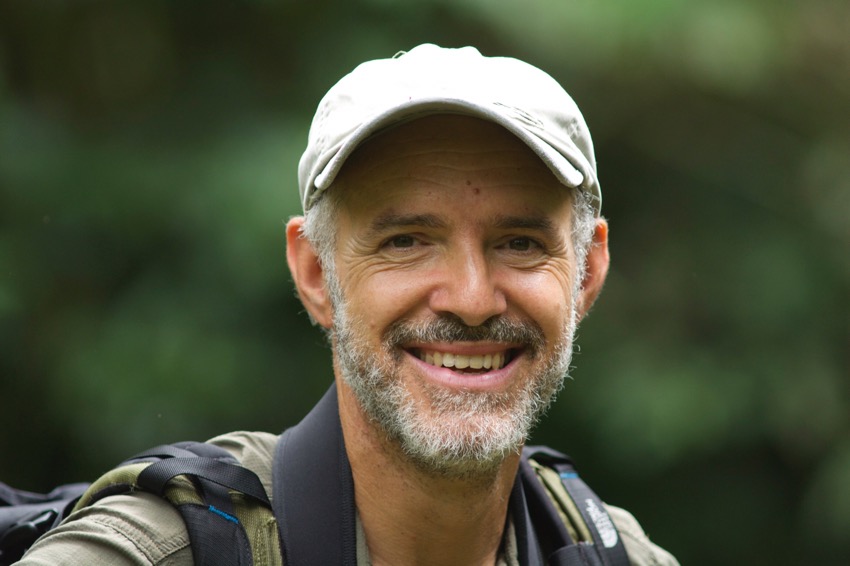
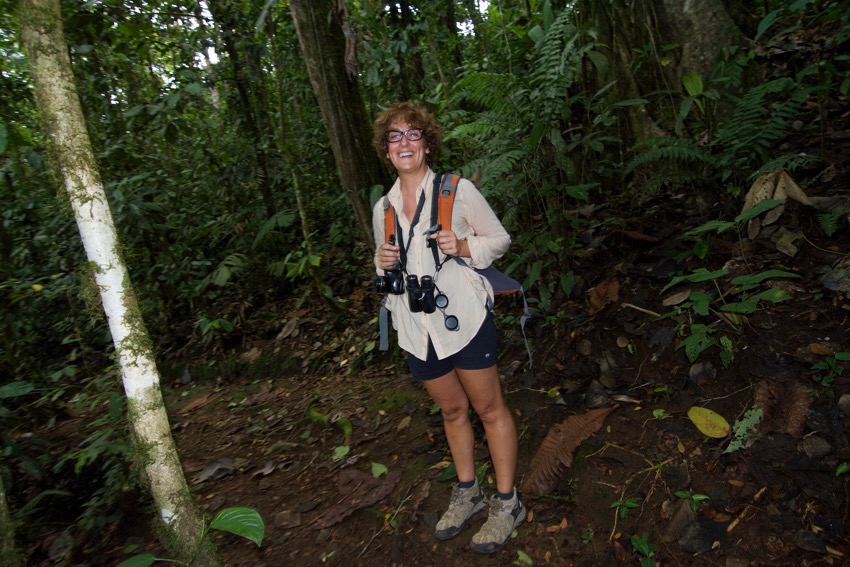
You gotta love the Internet.
For us, our trips begin long before they actually begin. For starters, we book them way in advance, often a year or more. So, we actually sorta forget about them until a month or so before we leave when it dawns on us, “holy shit, we leave for Borneo in a month, we’d better do something about that.” This means reading, preparing for what we’ll need, getting Malaria medication and, in this case, going to the wonderful Field Museum of Natural History in Chicago.
And that’s a bit of a story, too. A couple of years ago, I met John Bates, the co-curator of ornithology at the museum–at Wrigley Field. However much I know you would love to hear it, I’m not going to tell you how I met an ornithologist at the home of the World Champion Chicago Cubs.
Anyway, because of the incredible chutzpah with which I am blessed (or cursed), I contacted John and asked him how he’d like to give us and our friends, Michael and Valerie Lewis (of which, more later), with whom we are traveling to Borneo, a primer on Bornean birds. John said he’d be happy to, so we met him there where he talked with Carol and me, and the Lewises, about and showed us specimens of some of the birds we would see. The Field Museum has one of the couple largest collections of bird specimens in the world, numbering more than half a million.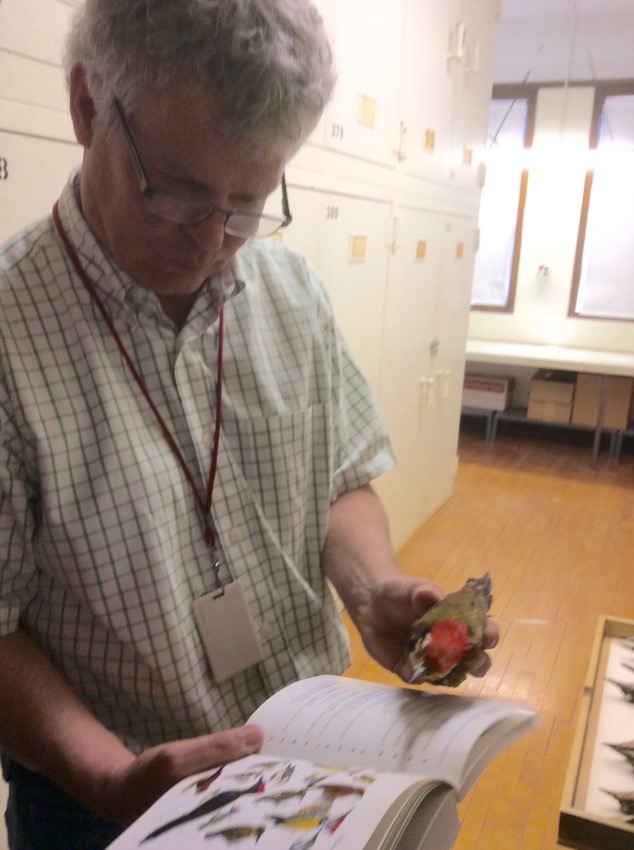
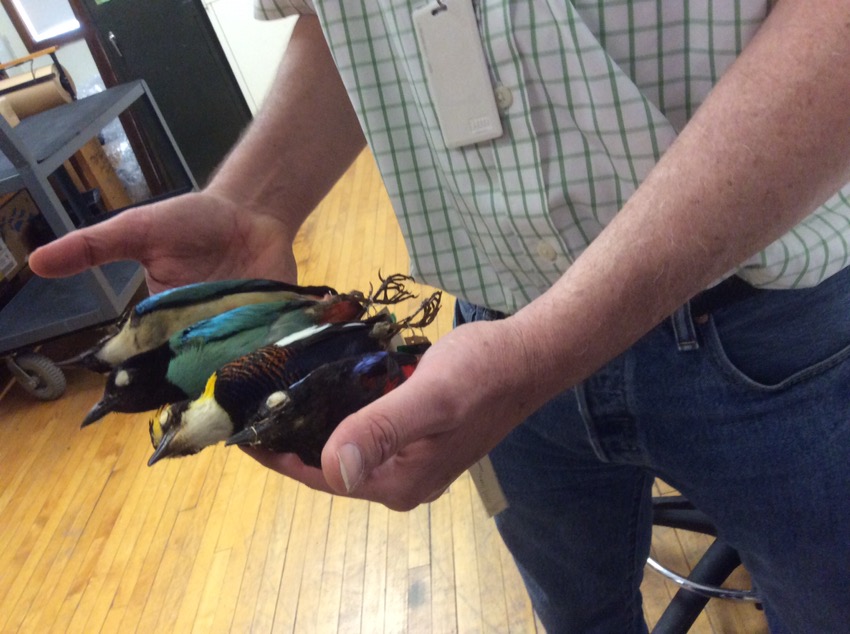
John also introduced us to a colleague at the museum. While I generally hate people who quote themselves, I am going to make an exception for me (with apologies to those who saw this on Facebook).
I met a guy the other day who likes frogs.
That may be a bit of an understatement.
Bob Inger is Curator Emeritus of Amphibians and Reptiles at the Field Museum of Natural History in Chicago. He is the world’s expert on Bornean frogs (frogs from Borneo).
Bob is 95 years old and made his first trip to Borneo to observe frogs in 1950. While he’s lost track of exactly how many trips he’s made to Borneo, he guesses it’s around thirty. Some of his trips involve six months in the field, observing. Bob collaborates with his wife, Tan Fui Lian, a native of Borneo and former naturalist at Kinabalu Park in Sabah, located in the Malaysian part of Borneo. They are pictured here, with the cover of one of their books, The Amphibian of Borneo, in the background.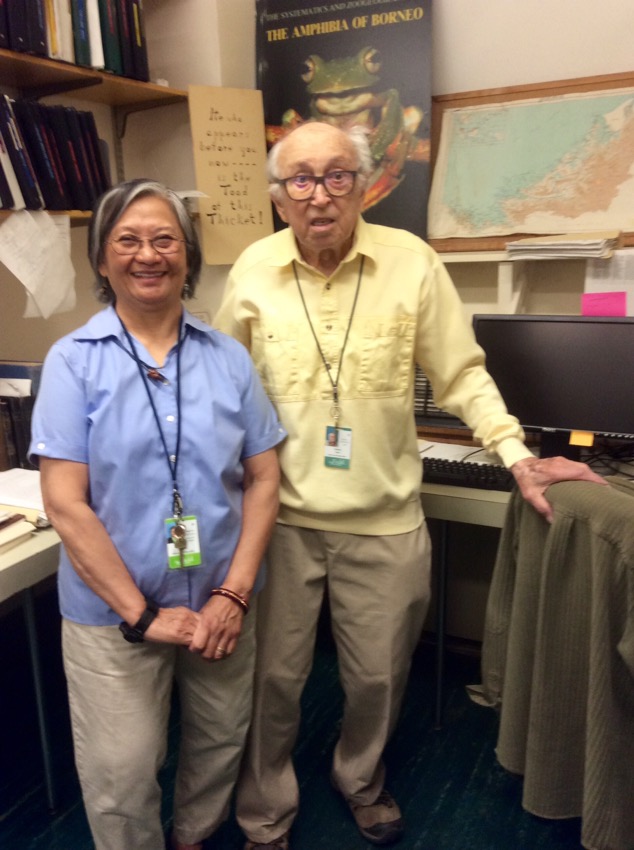
My wife and I, and two friends who will be traveling with us to Borneo in a few weeks, spent an hour with Bob and Tan Fui talking frogs. By talking frogs, of course you understand, I mean talking about their ecological distribution, their reproductive behavior, their physiology and their movements. We talked, too, about the enormous changes that have taken place in his field in Bob’s seventy years of work. When you’re 95, and you still light up when talking about frogs, you’ve got something going for you.
And shame on those of you muttering to yourself that Bob ought to “get a life.” Bob has a life. A damn good and passionate life. And all of us would do well to try to find something remotely approaching his level of passion in our own lives.
We were going to Borneo to see birds and orangutans, but you can bet that we’re now going to find us some frogs.
Okay, I’m going to end here, because I’ve undoubtedly tried your patience already. But I’m not going to apologize, because these side stories are hardly irrelevant. In fact, they are a large part of what makes travel such a joy for me. I’ll give you the stuff about Borneo that I’ve stolen from others in my next post.
|
|








































